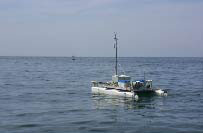SCIMS - A Semi-Autonomous System for Sampling
and
Extraction of Surfactants in the Sea-Surface Microlayer
Nelson M.
Frew, Principal Investigator
In collaboration with: Robert K. Nelson,
Nick Witzell,
Frederick T. Thwaites, Robin Singer, and Carl G. Johnson
Woods Hole Oceanographic Institution, Woods Hole, MA 02543

|
|
Click
on figure to enlarge
|
|
INTRODUCTION
Sea surface films affect the air-sea
exchange of heat, mass, and momentum. The occurrence, spatial
distribution, concentration and composition of sea surface
films are not well known (Frew, 1997; Frew et al., 2001).
Modeling the impact of the surface microlayer on air-sea
exchange processes requires an understanding of many factors
including:
• film formation rates and persistence as a function
of wind stress
• patchiness of film distributions over a range of
spatial scales (10m-1km)
• elasticity variations on these spatial scales
• film composition as a function of film pressure,
wind stress, and seasonal factors.
To meet these needs, a new survey tool, SCIMS (Slick
Chemical
Identification
and Measurement
System),
which detects the presence of surface microlayer films and
allows mapping of their spatial and temporal distributions
is described. Examples of time-series surface film enrichment
and mass spectra of film materials collected during two
recent field deployments are presented.
SCIMS
OVERVIEW
SCIMS consists of a surface microlayer
skimmer (SMS) coupled to a fluorometry package and an automated
extraction interface. Deployed on a remotely-piloted catamaran,
SCIMS processes the skimmer flow stream, carrying out cyclical,
microscale solid-phase extraction, concentration, desalting,
and elution of microlayer surface-active organics for short-term
archiving in an autosampler-compatible vial array. The time-series
‘snapshots’ of the extracted microlayer are
then processed by a lab or shipboard ion trap mass spectrometer
(ITMS) to develop the surface compositional profile of the
area surveyed by the skimmer, with a temporal resolution
of about 10 minutes. The mass spectral information can be
further used with elasticity data to develop correlative
relationships between film composition and elasticity. SCIMS
also provides real-time measurements of microlayer and subsurface
colored dissolved organic matter (CDOM) fluorescence with
1-second resolution.
|
|

